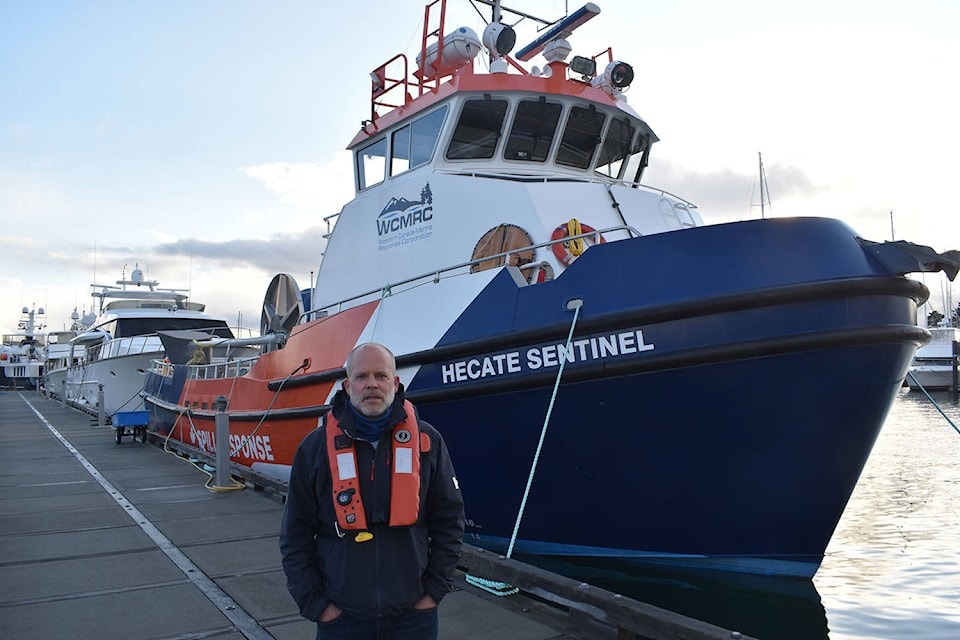Don’t blame the fire department for fires.
That is the spirit of the message from Michael Lowry, communication manager with Western Canada Marine Response Corporation (WCMRC), as the organization continues to build its new spill response base on the Saanich Peninsula as part of the Trans Mountain Expansion Project.
The expanded base will consist of a warehouse-office building under construction since early November near Victoria International Airport in North Saanich and a fleet of vessels anchored at Sidney’s Van Isle Marina.
Plans call for the enhanced base to be fully operational by the late fall of 2022 with eight vessels and about 24 staff available 24-7. Four vessels are already operating out of the marina, according to Lowry.
The base is one piece of confirmation that the expansion of the Trans-Mountain pipeline with its increased tanker traffic through the area is going ahead despite opposition.
Prominent critics of the project include the MP of the riding in which the base will operate, former Green Party leader Elizabeth May of Saanich Gulf Islands.
Lowry said he recognizes that the expansion is a “sensitive project.” This said, the base responds to a genuine, growing need.
| This map shows the enhanced marine spill response bases operated by Western Canada Marine Response Corporation (WCMRC) (WCMRC/Submitted) |
RELATED: VIDEO: Canadian, U.S. Coast guards run oil spill response drills
“Most people we talk to understand that they may not be supportive of a particular project, but they understand the need to have good spill response in place,” he said.
Funded by the oil and marine industry and subject to federal oversight, WCMRC operates under federal law requiring pollutors to pay, said Lowry.
“We are essentially the fire department for the ocean,” he said.
To continue the analogy, the Sidney-North Saanich base will be one of several new ‘fire halls’ along tanker shipping routes to and from Vancouver as the WCMRC is also building bases in Nanaimo, Port Alberni, Ucluelet, Beecher Bay, Vancouver Harbour and Fraser River.
The expansion valued at $150 million (with $4 million coming to Saanich Peninsula) will see WCMRC almost double its fleet from 44 vessels to 90 and its employees to 200.
Lowry said WCMRC chose Sidney and North Saanich for “very strategic reason” with all bases stationed in locations based on the risk of spills.
“There are spots on those shipping lanes that are at slightly higher risk,” he said. “For example, where the shipping lanes intersect with ferry traffic, where they have to make certain turns. Those are areas that we have looked at. When you look at risk, you also look at the consequence side of it as well. So if you are looking at the Sidney base, it’s right where the Gulf Islands are. So we want to be able to respond very quickly to any incidents in the Gulf Islands.”
Lowry also added that the presence of the new base will have broader benefits in helping to deal with any kind of spill, not just those related to the expansion project, and help train local responders.
WCMRC has been operating on West Coast since 1970s, starting a co-operative for the spill response industry based in Vancouver Harbour. Following the Exxon Valdez disaster, WCMRC expanded to cover the entire west coast of BC with the federal government assuming regulatory oversight.
The Trans-Mountain Expansion twins an existing oil pipeline from Alberta to British Columbia and expands a marine terminal in the Lower Mainland with the goal of expanding Canadian oil shipments to foreign markets in Asia. It is expected to be operating at the end of 2022.
The controversial project has been the political and judicial wranglings since its formal start in 2013 but cleared its final hurdle in the summer of 2020 when the Supreme Court of Canada gave the project a judicial green light.
Canada’s federal government purchased the pipeline in 2018 for $4.5 billion. Its estimated final price tag is $12.6 billion.
Do you have a story tip? Email: vnc.editorial@blackpress.ca.
Follow us on Twitter and Instagram, and like us on Facebook.
